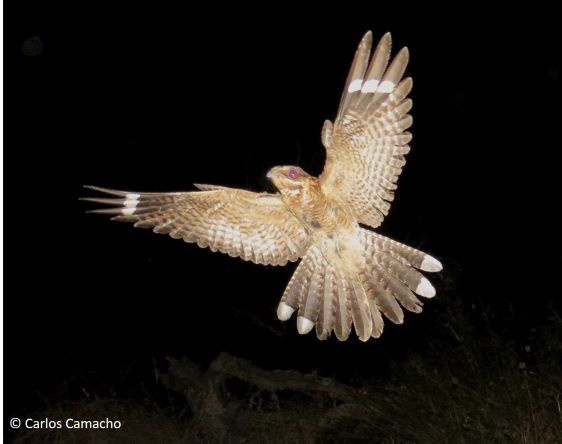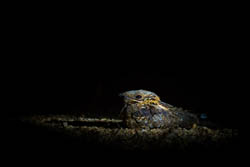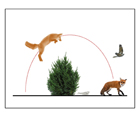Many nocturnal animals, including invertebrates such as scorpions and a variety of vertebrate species, including toadlets, flying squirrels, owls, and nightjars, emit bright fluorescence under ultraviolet light. However, the ecological significance of this unique coloration so attached to nocturnality remains obscure. An intensively studied population of migratory red-necked nightjars (Caprimulgus ruficollis) was used to investigate inter-individual variation in porphyrin-based pink fluorescence according to sex, age, body condition, time of the year, and the extent of white plumage patches known to be involved in sexual communication. Males and females exhibited a similar extent of pink fluorescence on the under-side of the wings in both juvenile and adult birds, but males had larger white patches than females. Body condition predicted the extent of pink fluorescence in juvenile birds, but not in adults. On average, the extent of pink fluorescence in juveniles increased by ca. 20% for every 10-g increase in body mass. For both age classes, there was a slight seasonal increase (1–4% per week) in the amount of fluorescence. These results suggest that the porphyrin-based coloration of nightjars might signal individual quality, at least in their first potential breeding season, although the ability of these and other nocturnal birds to perceive fluorescence remains to be unequivocally proven. información[at]ebd.csic.es: Camacho et al (2019) Correlates of individual variation in the porphyrin-based fluorescence of red-necked nightjars (Caprimulgus ruficollis). Scientific Reports. DOI: 10.1038/s41598-019-55522-y
https://www.nature.com/articles/s41598-019-55522-y

 Las aves nocturnas podrían comunicarse a través de la fluorescencia de sus plumas
Las aves nocturnas podrían comunicarse a través de la fluorescencia de sus plumas

